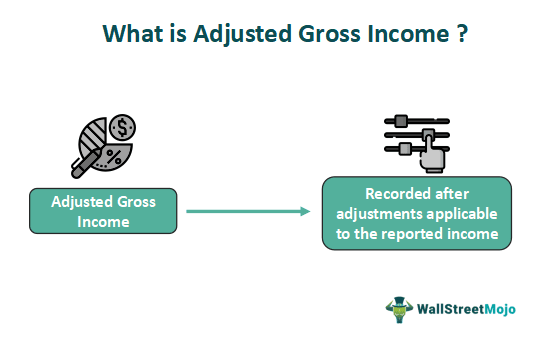Table Of Contents
What Is Adjusted Gross Income?
Adjusted Gross Income (AGI) is calculated from the gross income and represents the net amount of income earned by an individual in a year, including wages, capital gains, and retirement distributions, etc. after deducting above-the-line deductions. It is used to find out the taxable income of the individual, which is a way of determining deductions or credits a person is eligible to receive.

AGI is a metric that the Internal Revenue Service (IRS) uses to measure the income level of a taxpayer to determine their tax liability for a year. The figure obtained after subtracting deductions from the gross income is the income that is subject to taxation.
Adjusted Gross Income Explained
Adjusted gross income is the income generated after the income from all sources is added and from which the applicable deductions are made. The figure then obtained is the income on which tax is levied or calculated. This adjusted gross income on taxes is what taxpayers report on Schedule 1 of the tax return while they file their annual tax return.
AGI is a modified version of gross income as the gross income is the total amount of money earned by an individual in a year, including dividends, wages, capital gains, rental income, etc. In contrast, there are some above-the-line deductions in the calculation and therefore, more useful for the individual who pays tax as it makes the individual eligible to receive deductions and credits.
The deductions applicable on the AGI include alimony, educator expenses, early withdrawal penalties on the amount saved, Health Savings Account (HSA) deductions, self-employment tax, etc.
The adjusted gross income AGI, calculated by deducting applicable deductions from the gross income, has a significant impact on the deductions and credits, as due to it an individual can get deductions and credits on the tax return. The value of these deductions and credits depends upon the average gross income, which means if the AGI is low, the individual will enjoy more deductions or credits and vice-versa.
How to Calculate?
The first step in calculating the adjusted gross income is finding out the accurate gross income of the individual by adding other sources of income to the total income earned in a particular year. Other sources of income include unemployment compensation, social security payments, profit from the sale of the estate, pensions, and so on.
On ascertaining the gross income, we deduct above-the-line deductions from it. Above-the-line deductions are the deductions applicable to the taxpayer; we can find a complete list of such applicable deductions on the website of the Internal Revenue Service (IRS). After deducting these applicable deductions from the gross income, the resultant value is the adjusted gross income (AGI).
Formula
To calculate adjusted gross income, the following expression is used:
Adjusted Gross Income = Gross Income From All Sources – Applicable Deductions
Example
Suppose, an individual breaks down the deductions and summary ophthalmology expenses that can’t be repaid by insurance. The individual may have grabbed a deduction of the ophthalmology expenses surpassing the mark of 10% of average gross income for the year 2018.
If the individual reports the unrepaid amount of $12,000 as the ophthalmology expenses while having an average gross income of $100,000, then he must reduce the deductions by the amount of $7500. Doing so will leave the individual with a $4,500 deduction. And if the average gross income of the individual is $50,000, then the individual has to reduce $3,750 ending up with an $8,250 deduction.
Benefits
The advantages of adjusted gross income are as follows:

- Helpful in finding the taxable income: The adjusted gross income helps in finding the accurate taxable income of an individual as the applicable deductions are deducted from the gross income in it.
- A source of deductions and credits: It helps individuals by making them eligible to receive deductions and credits.
- Legal acceptance: The adjusted gross income on Form 1040 is calculated per the very first page of the U.S federal tax return by using the information from schedule 1.
Adjusted Gross Income Vs Modified Adjusted Gross Income VS Gross Income Vs Taxable Income
Though adjusted gross income (AGI) and modified adjusted gross income (MAGI) sound similar in their use and approach, these two forms of gross income differ widely. Similarly, AGI differs from gross income and taxable income as well.
Listed below are a few differences between the above terms:
- AGI is the income figure obtained after the applicable deductions and adjustments are subtracted from the gross income of an entity. MAGI, on the other hand, is the amount that is calculated after AGI is obtained. It marks the addition of certain elements that include deductions related to educational fees or charges.
- While AGI helps find the figure on which tax is levied, MAGI helps determine the ability of an individual or entity to contribute to a Roth IRA in a particular year.
- The Gross income is the total income generated from all sources, including wages, salary, dividends, etc. On the other hand, AGI is the amount obtained after deductions and adjustments are subtracted from the gross income.
- For the AGI, when taxpayers consider either standard deductions applicable or deductions itemized, the figure obtained is the taxable income.
